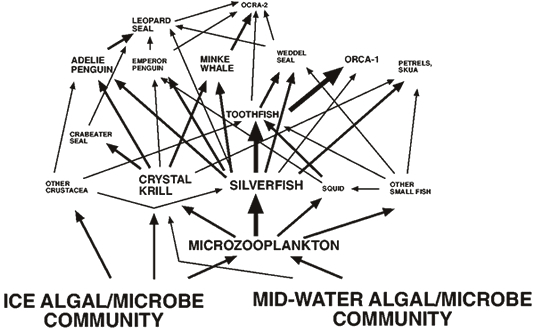Marine food web
In Antarctica, light is the most important environmental factor affecting marine organisms. Without it, plants that are the base of all food chains cannot grow.

- The most important plants in the Southern Ocean are tiny algae called phytoplankton.
- The main types of algae are diatoms and dinoflagellates.
- Further south, the ice algae that grow under and within pack ice and snow are also important.
- Algae grow well in Antarctic waters because of a plentiful supply of nutrients brought to the surface by upwelling warmer water.
- Krill, small animals that feed on phytoplankton, dominate the zooplankton.
- There are about 600 000 billion krill in the Southern Ocean, weighing 500 million tonnes. They are the most abundant animal in the world.
- It is estimated seabirds eat more than 115 million tonnes of krill per year.
- The Antarctic food web is very sensitive to change. Any change in the numbers of one species is likely to have major impacts on others.
- Crabeater seals outnumber all other seals in the world put together.
Human impacts
- Humans currently harvest about 100 000 tonnes of krill per year, mostly in the same convenient locations used by seals and penguins. Dried krill are close to 50% protein and rich in vitamins, so this harvest can be expected to increase.
- Humans catch large numbers of Patagonian and Antarctic toothfish, and there is a danger this fishery could be over-exploited. (Only 120 of the 20 000 known species of fish live south of the Antarctic Convergence.)
- Long-line fishing kills more than 100 000 seabirds a year.
